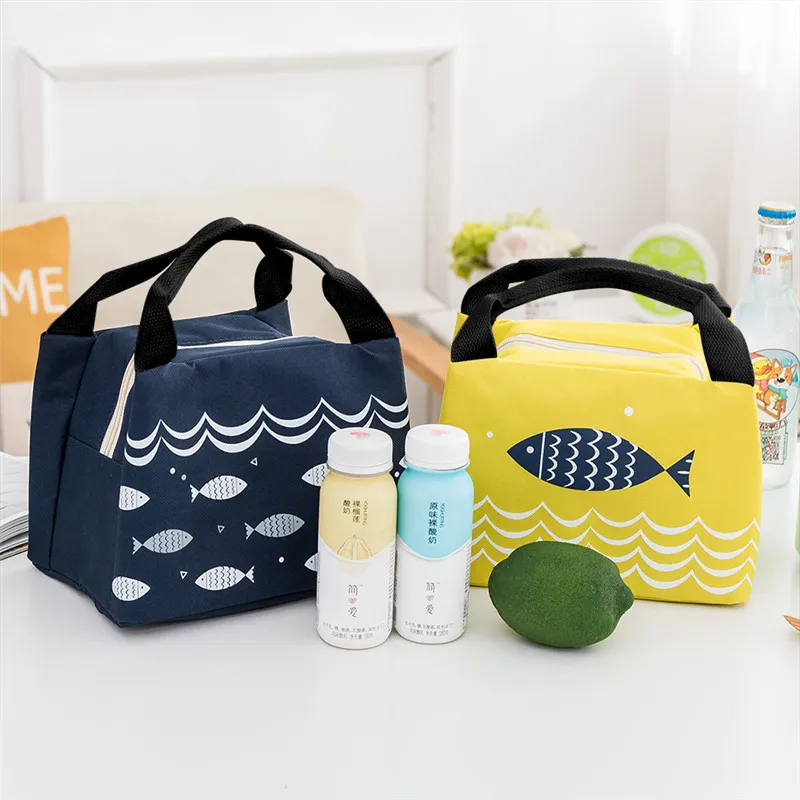Baby led weaning ideas first foods
Ultimate Guide to Baby Led Weaning (and Best First Foods)
Learn the basics of how to do the feeding approach known as “baby led weaning” and the best first foods for baby to make starting solids easy and fun. Plus: Learn why it’s perfectly okay to use a combined approach of blw and purees.
Baby Led Weaning
The feeding approach known as “baby led weaning” or “BLW” for short, is a style of feeding infants that allows them to feed themselves right from the start. The food is offered in thick finger-size pieces and is soft and easily squishable between your fingers. This way, the food is both easy to hold but has a low risk of choking.
TIP: This method became popular about a decade ago after the publication of the Baby Led Weaning: The Essential Guide to Introducing Solid Food by UK author Gill Rapley.
BLW Baby
One of the many reasons that people are starting to opt for this style of feeding more and more is simply that it’s easy. In many cases, you can modify foods you’re already making to share with your baby and there’s not always a lot of separate cooking involved. It also allows a baby to have control over what goes into their mouths, which sets a good precedent for letting them eat intuitively from the start.
What age should I start baby led weaning?
According to the American Academy of Pediatrics, a baby is ready to start solids with baby led weaning when:
- They’ve doubled their birth weight (at least).
- They can hold their head up well and are starting to sit up unsupported.
- They show signs of being interested in food (watching you eat, reaching for food when you’re eating, etc).
- When you feed them, they are able to move the food around in their mouths—rather than spit it right out.
TIP: Look for a highchair that allows a baby to sit up relatively straight so they can have good posture and better control over their arms and hands.
How to Start Baby Led Weaning
The first time you offer solids is such a fun milestone, so you’ll be ready once you follow these simple steps.
- Make sure baby has hit the milestones listed above to let you know that he’s ready to start.
- Get the highchair ready and adjust the straps and foot rest as needed.
- Plan to introduce water when you start solids. I recommend a trainer cup.
- Choose one food to start with and plan to offer only one food at a time.
- Stop when baby starts to fuss, turns his head away, or shows any other signs of not wanting to continue. It’s usually fairly obvious when they are done!
TIP: If you start offering solids and baby just doesn’t seem interested at all, it’s okay. Take a break for a few days or a few weeks and start again. Each kiddo has their own unique timeline.
Best Tips for Starting BLW
Here are a few more tips to consider and review before you get started.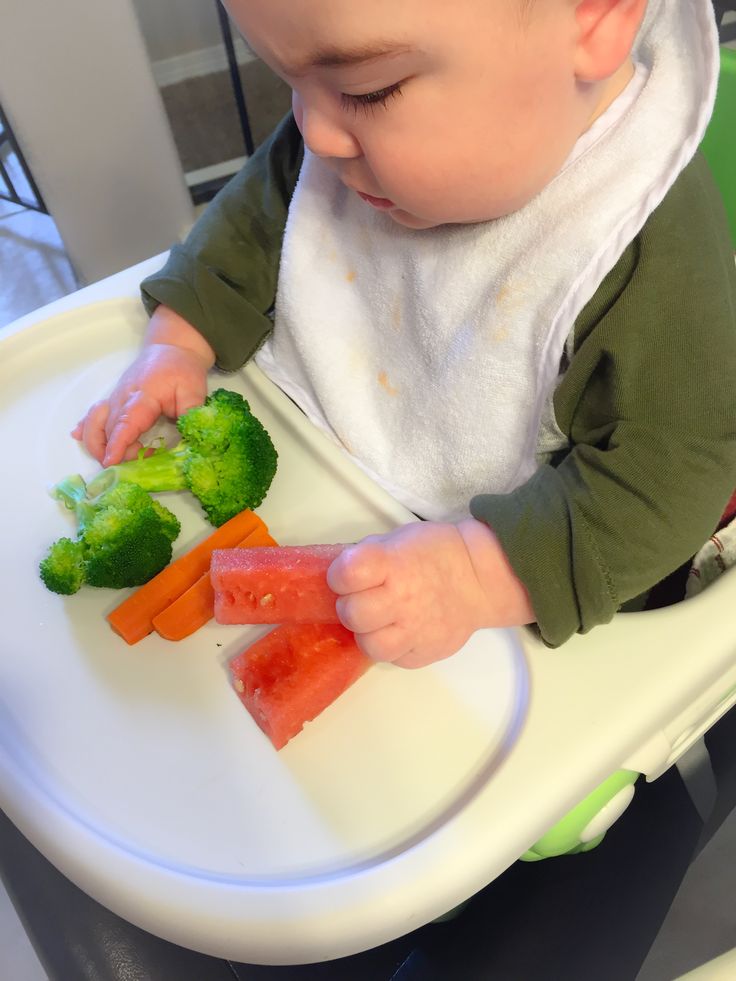
- Understand the gag reflex. Gagging is different than choking though and is most often a sign that baby is learning to move food around in their mouths—and to get it out of their mouths, which is a skill you want them to have!
- Brush up on the basics of how to know when baby is ready to start solids. (Go back to the top of this post for the signs to look for.)
- Set them up for success with a highchair that allows them to sit up straight and has foot support.
- Sit with them as you offer food.
- Check your own expectations of what will happen and simply allow your baby to take the lead.
- Start with one new food a day or every few days.
- Vary the textures of foods you offer to start exposing baby to many right from the start.
- Offer water in a sippy cup or small open cup.
TIP: Remember that breastmilk or formula will continue to satisfy baby’s hunger for the first few months of eating solids. Do not expect solids to replace milk feedings at this age.
First Foods for Baby
Starting solids with baby led weaning or purees are both perfectly acceptable ways to introduce a baby to solid foods—but the topic can get so heated! There’s a lot of pressure to do it the “right” way and I’m here to say that there isn’t one. You 100% can do one or the other, or combine the two to make it work for your family. It’s all good!
Remember, the goal with first foods for baby is that they’re introduced to flavors, nutrients, and foods they can easily eat or suck on. It should be an enjoyable milestone for all involved.
TIP: It’s a good idea to get into the habit of offering an iron-rich food since iron stores in babies start to run out around 6 months and they’ll need to start ingesting it in their food.
Best First Foods for Baby Led Weaning
Here are some of our favorite first foods to offer baby led weaning style. You want foods to be finger sized so they are large enough that baby can’t force the whole piece into their mouth, and a shape that’s easy for a 6 month old to hold with their chubby little hands. These are some of our favorites.
These are some of our favorites.
- Roasted sweet potato wedges
- Roasted apple wedges, skin on to help them hold together
- Roasted or steamed broccoli florets (big enough for baby to hold)
- Melon slices
- Thick mango slice
- Banana with some of the peel still on
- Toast sticks with mashed avocado
- Avocado spears (make sure the avocado is ripe and soft)
- Lamb or beef, on the bone or a large piece for baby to suck on
- Dark meat chicken, on the bone or a large piece for baby to suck on.
TIP: The foods should generally be soft enough to squish between your fingers with the exception of the large pieces of meat. If baby gnaws a piece down into a smaller piece, replace it with a larger one to avoid her putting a chunk of food into her mouth.
Baby Led Weaning Banana
To serve a banana to a baby, wash it well, then slice it in half. Cut off an inch or two of the peel, but leave the rest of the peel on so it’s not slippery for baby to hold. They’ll suck on the top part like a little popsicle! You can also help them hold the banana if needed.
They’ll suck on the top part like a little popsicle! You can also help them hold the banana if needed.
Foods to Avoid Serving While Doing BLW
You want any foods you offer to a baby while doing baby led weaning to be soft enough to squish between your fingers and safe for them to eat and digest. Plan to avoid:
- Anything hard, sticky, or crunchy (like raw apple or carrot, whole nuts, crackers, or a big spoonful or nut butter)
- Added salt
- Cow’s milk (which is difficult for kids under 1 to digest; plain yogurt is fine though)
- Added sugar (they simply don’t need it)
- Honey (to avoid a risk of botulism)
- Super slippery foods that would be hard for baby to hold (which can be frustrating)
TIP: Always sit with your baby and watch them try to eat. They are your best guide for making adjustments to the foods you serve.
Baby Led Weaning and Choking
There are many parents who dislike this method of feeding because it often sounds like a baby is choking. And while there are surely some incidences of choking, what’s more likely is that a baby will occasionally gag on a piece of food that gets into their mouth that they weren’t expecting.
And while there are surely some incidences of choking, what’s more likely is that a baby will occasionally gag on a piece of food that gets into their mouth that they weren’t expecting.
But remember: Gagging is a sign that baby is doing what she needs to in order to move the food around in their mouth as they learn to eat. It usually sounds more dangerous than it actually is.
TIP: If the sound of gagging really freaks you out, you’re not alone. Consider offering more preloaded spoons with purees to start your journey more slowly.
How to Cut Foods for BLW
You generally want the food to be big enough that it would be difficult for baby to put the entire thing into their mouths. Here are some specifics:
- Foods that are roughly the size of a finger, so about a 4-inch stick.
- Foods that are easy for the baby to pick up—they can’t pick up small pieces until closer to 9 months when they develop the ability to use their fingers in what’s known as a “pincer grasp”.

- Foods that aren’t too slippery—so you can wash and leave some of the peel on fresh foods like bananas, avocado, kiwi, and mango.
TIP: You can also go even bigger if you’re worried about size. Think half of a slice of bread or a big chunk of watermelon.
Will my baby actually eat much food with BLW?
Probably not at first. There will likely be more tasting of the food than eating of it and that is totally fine. They will still rely on breast milk or formula at this age for their main nutrition, so don’t expect them to suddenly start eating full meals. (They’ll get there in a few months, but it takes time!)
Do babies need teeth for baby led weaning?
No! Gums are super strong and front teeth aren’t used for chewing—that happens when the back molars come in. Teeth really have nothing to do with whether or not a baby can eat solids.
TIP: Learn more about what to expect from teething here.
Can you mix baby led weaning and purees?
Absolutely! I think it’s a great idea to mix the two methods simply because it gives you many more options for foods and allows the baby to experience more textures. I recommend allowing babies to feed themselves preloaded spoons—so you put the puree on a spoon, then hand it to them to actually put the spoon into their mouth—so they still have control over what goes into their mouths.
I recommend allowing babies to feed themselves preloaded spoons—so you put the puree on a spoon, then hand it to them to actually put the spoon into their mouth—so they still have control over what goes into their mouths.
TIP: Feeding some purees is also helpful if you’ll be sending food with a baby to daycare since the care provider may not have experience with blw.
Best First Foods for Baby: Purees
Here are some of our favorite purees to start offering baby when they’re ready to start solids. Remember: There’s no evidence that says that you need to start with vegetables versus fruits, so go with something that tastes good to you. Start with single foods pureed smooth and offer just a little at a time on a spoon.
- Mashed roasted sweet potato puree
- Mashed avocado puree
- Mashed banana puree
- Butternut squash puree
- Applesauce, unsweetened
- Mashed pea puree
- Oatmeal baby cereal (with added iron)
TIP: One of my favorite baby food companies is Amara Organic Baby Food, a company using a nutrient protection technology that makes organic purees just as good as homemade. I love how easy they are to use when I need a shortcut and that they have fun baby-led weaning recipes on the side of every box! (paid affiliate link)
I love how easy they are to use when I need a shortcut and that they have fun baby-led weaning recipes on the side of every box! (paid affiliate link)
How do I know when baby has had enough?
If your baby is eating and then starts to turn her head away or just refuses to open her mouth, she’s done! Babies may also start to fuss if they’ve had enough. Learning this new skill takes time and babies can become tired fairly quickly into the process, so don’t expect them to always eat very much or to last very long at the table. This stage is about exploration!
Baby with preloaded spoon of yogurtHow to Let Baby Self Feed Purees
I love offering purees on a preloaded spoon. To do this, the parent, puts some of the food on the spoon and hands it to baby. Then baby can bring the food to their mouth all by themselves. This gives you some of the same advantages of baby led weaning, but can be more comfortable for many parents.
Remember, you can mix what you offer, going back and forth between purees and blw finger foods, so you can offer the same food two different ways to let baby explore. The main goal is to avoid forcing baby to take more bites than they want to, which can sometimes happen with purees.
The main goal is to avoid forcing baby to take more bites than they want to, which can sometimes happen with purees.
When to Introduce Potentially Allergenic Foods
In recent years, guidelines have been updated on when to introduce potential allergens including peanuts, eggs, and shellfish, so unless you have a family history of a food allergy, you can go ahead and introduce them soon after baby starts eating solids. In fact, research is showing that introducing these foods early can actually protect baby from developing an allergy. Talk to your pediatrician if you have concerns.
TIP: Thin unsweetened peanut butter with water to form a very thin Peanut Butter Puree until it’s about the consistency of regular yogurt and offer a very small amount on a spoon or spread on a toast stick.
What does a baby led weaning meal look like for months 7 and 8?
Until a baby is closer to 9 months and is able to pick up smaller pieces of foods, but after they have gotten the hang of one food at a time, I try to offer 1-2 foods they can feed themselves and one puree.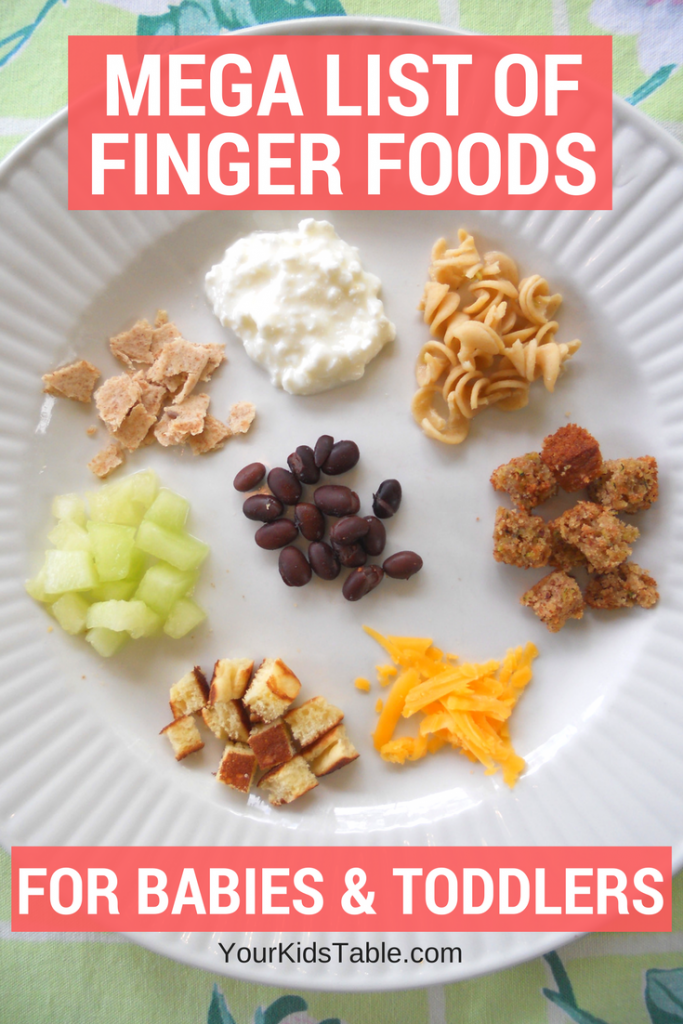 This offers them a chance to ingest more via the puree but still feed themselves a range of textures. You can do more or less food following the lead of the child.
This offers them a chance to ingest more via the puree but still feed themselves a range of textures. You can do more or less food following the lead of the child.
TIP: My Baby Food Chart has loads of with ideas for blw foods and purees by month.
Recipes for Every Stage of Starting Solids
If you’re ready to start solids with baby, or you’re just curious what it looks like to do a mix of baby led weaning and purees, check out my Yummy Baby Food cookbook. It goes stage by stage with specific foods to start in each, with simple recipes and easy feeding tips.
Listen to a recent podcast episode to hear about some of the basics of BLW with our guest Megan McNamee, MPH, RDN, CLT, and a Registered Dietitian Nutritionist specializing in pediatric nutrition who runs Feeding Littles.
I’d love to hear any questions you have with BLW or if your baby had a first food that I didn’t list here. Please comment below to share your experience!
Prep Time 5 minutes
Total Time 5 minutes
Author Amy Palanjian
Cuisine American
Course Dinner
Calories 28kcal
Servings 1
Banana
- ▢ 1 small ripe banana with peel on
Roasted Sweet Potato
- ▢ 1 small sweet potato + 1 teaspoon olive oil
Roasted Apple
- ▢ 1 small apple + 1 teaspoon butter or neutral oil
Roasted Broccoli
- ▢ 1 cup broccoli florets + 1 teaspoon olive oil
Sauteed Green Beans
- ▢ 4 green beans 1 teaspoon olive oil
Melon
- ▢ 1 small piece watermelon or cantaloupe
Avocado Toast
- ▢ 1 slice whole grain bread
- ▢ 1 tbsp ripe avocado
Avocado Spear
- ▢ ⅛ ripe avocado
Lamb or Beef
- ▢ 1 lamb chop, roast, or steak
Pan-Seared Chicken Thighs
- ▢ 1 chicken thigh
- ▢ 1 tsp olive oil
- ▢ 1 garlic clove, optional
Banana with some of the peel still on
Cut a banana in half.
 Use a knife to gently cut around the peel about 2 inches down, leaving some of the peel on so that the banana is easy for baby to hold and less slippery.
Use a knife to gently cut around the peel about 2 inches down, leaving some of the peel on so that the banana is easy for baby to hold and less slippery.
Roasted Sweet Potato Wedges
Preheat oven to 400 degrees and line a rimmed baking sheet with foil. Wash and dry the sweet potato. (You don't need to peel it.) Cut in half, then cut lengthwise into strips. Cut each strip in half again until each is about 1/2-inch thick. Slice in half horizontally if the sweet potato is very long. (Each strip should be about the size of your finger.) Place into a bowl and toss with the olive oil. Spread onto prepared baking sheet and roast for 22-25 minutes or until soft. Let cool slightly and serve.
Roasted Apple Wedges
Roasted Broccoli Florets
Preheat the oven to 400 degrees F. Place the broccoli onto a rimmed baking sheet and toss with the olive oil, coating and mixing well until all of the florets are a little shiny and coated with oil.
 Roast for 15-18 minutes or until tender. Let cool slightly and serve.
Roast for 15-18 minutes or until tender. Let cool slightly and serve.
Sauteed Green Beans
Warm the oil in a large skillet over medium heat. Add the green beans and stir. Cover and cook for about 8 minutes. Remove cover and taste one to see if it’s soft enough. Cook for an additional minute or two as needed.
Melon slices
Avocado Toast
Avocado Spears
(Make sure the avocado is ripe and soft): Cut a thick strip of avocado and offer to baby. You can leave the peel on if that makes it easier for baby to hold (just wash it first).
Lamb or Beef
Prepare a roast, steak, or chop without salt and with butter or olive oil until cooked medium well. Offer a thick slice at least the size of your finger or a drumstick.
Pan-Seared Chicken Thighs
Warm 1 tablespoon olive oil or butter in a large skillet over medium heat. Add the chicken thigh and top with a few slices of fresh garlic, if desired.
 Cover and cook for 4-5 minutes. Remove cover. Flip over and cook for an additional 4-5 minutes uncovered or until a meat thermometer registers 165 degrees F.
Cover and cook for 4-5 minutes. Remove cover. Flip over and cook for an additional 4-5 minutes uncovered or until a meat thermometer registers 165 degrees F.
- Add spices like garlic powder, cinnamon, cumin, oregano, or any other non-spicy flavor you like to make these more interesting.
- Offer just one piece at a time when starting out.
- If baby gnaws a piece down into a smaller piece, replace it with a larger one to avoid her putting a chunk of food into her mouth.
- Store any leftovers in an airtight container in the fridge for 3-5 days. Reheat briefly if needed.
- Remember that it's normal for babies to take time to actually ingest the food. Part of the process is exploring all of the senses related to the experience of eating.
Calories: 28kcal, Carbohydrates: 2g, Protein: 1g, Fat: 2g, Saturated Fat: 1g, Polyunsaturated Fat: 1g, Monounsaturated Fat: 2g, Sodium: 6mg, Potassium: 75mg, Fiber: 1g, Sugar: 1g, Vitamin A: 23IU, Vitamin C: 2mg, Calcium: 2mg, Iron: 1mg
Tried this recipe?Rate in the comments and tag @yummytoddlerfood on IG!
Printable Baby Food Chart: BLW, Purees, Finger Foods
Make feeding your baby easier with this free, downloadable baby food chart.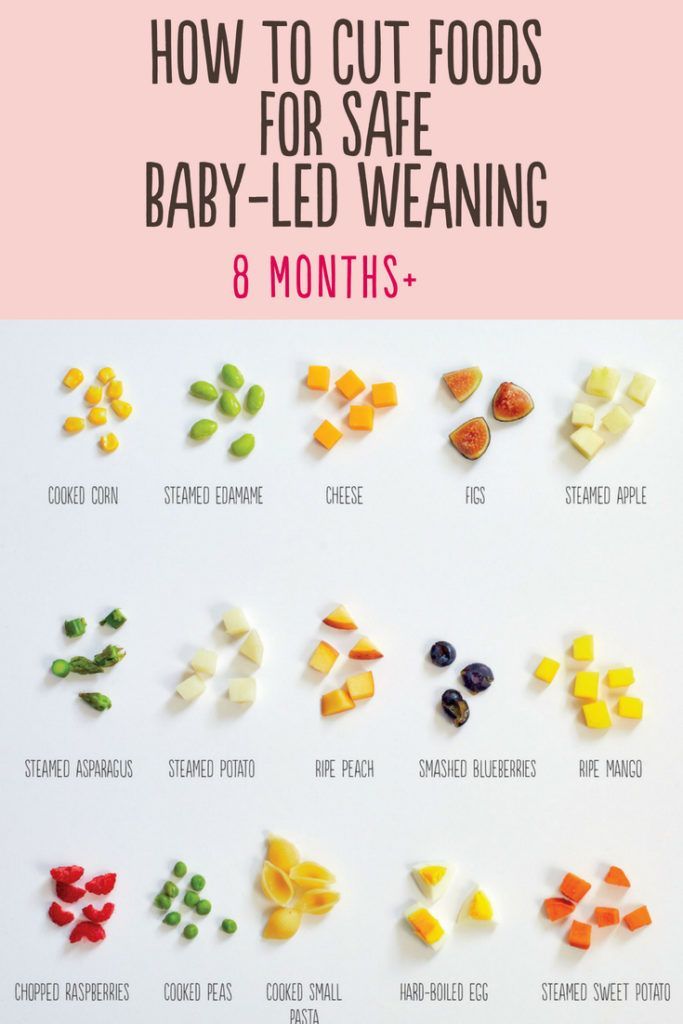 It has straight forward ideas for what to feed baby from when they start solids on up to one year—including purees, baby-led weaning style foods, finger foods, and more.
It has straight forward ideas for what to feed baby from when they start solids on up to one year—including purees, baby-led weaning style foods, finger foods, and more.
Baby Food Chart
Starting solids with a baby can be so fun and often a little challenging—but this baby food chart will help. I’ve compiled my best ideas for which foods to serve based on age and development of the baby to make it easy for you to make decisions in the kitchen.
This infant feeding chart is meant to help remind you of options you have at each age. It is not meant to add any pressure or function as a checklist of foods you have to serve (unless you want to do that!).
TIP: Download your free printable baby food chart here.
What baby foods should you start with?
Whether you start with purees or baby led weaning, starting with flavorful and nutrient-dense foods is a simple way to think about introducing foods to a baby. I love simple foods like roasted sweet potato, avocado, banana, and apple puree as first foods for a baby.
Remember that a first food is just that—a first food. It is not going to be the sole thing that determines how your child likes all foods. It can be sweet or savory, or from a variety of food groups. I would do your best to make sure that the food is easy to eat, has some flavor, and that the environment in which you offer it is free from pressure and, maybe even joyful!
What age should baby start eating foods?
The American Academy of Pediatrics recommends waiting to start solids until a baby is 6 months, and to go with wide variety of foods, introduced one at a time. But many pediatricians still say it’s okay to start rice cereal at 4 months.
If your pediatrician recommends this at the 4 month check up, ask their thoughts on the recommendation from the AAP.
TIP: Learn more about starting solids here.
How much food should I feed my baby?
The best way to know the right amount of food to give to a baby is to follow their lead. It should be very clear when a baby is done eating—they will close their mouth, turn their head, and generally make it very hard to feed them. (They may also play with their food, which is a fine way for them to interact with the foods at this early stage.)
It should be very clear when a baby is done eating—they will close their mouth, turn their head, and generally make it very hard to feed them. (They may also play with their food, which is a fine way for them to interact with the foods at this early stage.)
It’s okay if baby eats very little to start. It’s also okay if they surprise you by being very interested in food!
TIP: Download your free printable baby food chart here.
6 Month Baby Food Chart for Purees
If you’re ready to start solids with a baby, here are some foods you may want to start with. This list is perhaps more broad than you expect, but more recent research shows that it’s a good idea to introduce potential allergenic foods earlier and that lots of flavor is a great way to set baby up for eating a range of foods as they grow.
Don’t feel like you need to serve all of these foods (you 100% don’t!), but it should give you a range of ideas to consider based on season, availability, and your own preference.
- Almond butter puree
- Apple Puree
- Avocado puree
- Banana puree
- Baby oatmeal
- Bean puree
- Butternut squash puree
- Egg yolk, hard cooked mashed with water
- Green bean puree
- Melon puree
- Pea puree
- Peach puree
- Peanut Butter Puree
- Pear puree
- Pumpkin puree
- Sweet potato puree
- Whole milk plain yogurt
- Single ingredient baby food
TIP: Find more in depth details on how to know if your baby is ready to start solids here.
6 Month Baby Food Chart for Baby Led Weaning
If you decide to use the baby led weaning method of feeding, you’ll want to cut these foods into the shape of a finger or larger. The foods should also be soft and easily squishable between two fingers—like the texture of a roasted sweet potato wedge or ripe avocado.
You don’t need to feel like you have to serve all of these foods by any means, but it should give you a range of ideas.
- Apple, roasted wedge
- Avocado spears
- Banana
- Beef, ground (large piece)
- Beef hamburger patty (sliced)
- Beet, steamed or roasted
- Broccoli florets, roasted/steamed
- Cauliflower florets, roasted/steamed
- Chicken, dark meat shredded
- Cucumber
- Green bean
- Egg, hard cooked
- Egg in omelet, sliced
- Figs, halved
- Lamb
- Mango slice
- Meatball
- Melon slices
- Peach, very ripe slice
- Pear, very ripe slice
- Potato, roasted wedges
- Steak slice
- Sweet potato, roasted wedges
- Toast with mashed avocado
- Toast with mashed sweet potato
- Toast with light smear of peanut butter
- Toast with mashed hard cooked egg
- Watermelon slice
- WiId salmon
TIP: Find my Ultimate Guide to Baby Led Weaning here.
7 Month Baby Food Chart
With a 7 month old baby, you can add in a few more foods including those with more acid like citrus. Continue serving the foods on the 6th month list, or introduce ones that you didn’t get to in that first month.
Continue serving the foods on the 6th month list, or introduce ones that you didn’t get to in that first month.
- Baby rice crackers
- Bean puree
- Beet puree
- Brussels Sprouts, pureed (or large piece for BLW)
- Guacamole
- Kiwi puree (or large piece for BLW)
- Hummus
- Mango Puree
- Mixed ingredient baby foods
- Orange segment for BLW
- Pineapple puree (or large piece for BLW)
- Prune puree
- Strawberry puree (or large strawberry for BLW)
- Spinach puree
- Smoothies (simple)
- Tomato sauce
- Tomato sauce with ground meat
TIP: Try my 10 easy No Cook Baby Foods.
9 Month Baby Food Chart
As a baby nears the 9 and 10 month mark, they will begin to be able to pick up small, pea-size pieces of foods with their fingers. This development of the “pincer grasp” means they are ready to start sampling table foods.
A good rule of thumb is to cut foods to about the size of a pea and to serve them very soft and easily squishable between your fingers.
Bread-like textures in foods like pancakes and muffins may be difficult for your child, so you may want to moisten them with water, applesauce, yogurt, breastmilk, or formula.
Remember that babies learn to eat a variety of paces, so follow the lead of your baby and avoid pressuring them to eat foods or amounts of foods that they aren’t ready for. If a baby turns their head away, closes their mouth, shakes their head, or cries, they are done with food and it’s okay to end the meal.
Continue serving foods from the previous months. And try adding:
- Banana, diced and mashed slightly as needed
- Barley, cooked until very soft
- Beans, slightly mashed
- Beef, ground
- Blueberries, diced
- Cheese, shredded
- Chex cereal
- Chia seed in smoothies, yogurt or oatmeal
- Chicken, ground
- Chicken, shredded and chopped into small pieces
- Clementines, diced (you may want to remove the slightly tough membrane)
- Cottage cheese
- Corn
- Flaxseed in smoothies, yogurt or oatmeal
- Goat cheese, soft crumbles
- Grapes, diced (never whole)
- Kefir, plain
- Meatball, diced
- Muffins, diced (moistened if needed)
- Millet
- O cereal
- Oatmeal
- Overnight oats
- Pasta
- Peas
- Potatoes, roasted or mashed
- Puffs
- Raspberries, diced
- Pancake, diced (moistened as needed with applesauce)
- Quinoa
- Rice
- Salmon, small pieces
- Tofu, diced
- Tomatoes, fresh
- Tilapia, small pieces
- Turkey, ground
TIP: Find my best Early Finger Foods, which will cover this stage and early toddlerhood.
Best First Finger Foods for Baby
I put together my go-to first finger foods for babies, which may help you narrow down which foods to start with. Each of these is a nutritious whole food that’s soft and easy for baby to eat. It’s helpful that many of these foods are ones that us grownups like too, so it should make meal planning and prep for the little ones easier on you!
Printable Baby Food Chart
Grab your free copy of my downloadable Baby Food Chart with access to my entire Resource Library of Printable charts by signing up for my newsletter.
You May Also Like
- ABC Baby Muffins
- Master List of Baby Snacks
- Extra-Veggie Baby Soup
- Sweet Potato Teething Biscuits
- Master List of Baby Food Recipes
I’d love to hear your feedback on this chart, so please comment below! I always love to hear from you guys.
This post was first published Jan 2019.
Weaning Tips for Babies
Search Support IconSearch Keywords
Home ›› How to Wean Your Baby
close communication.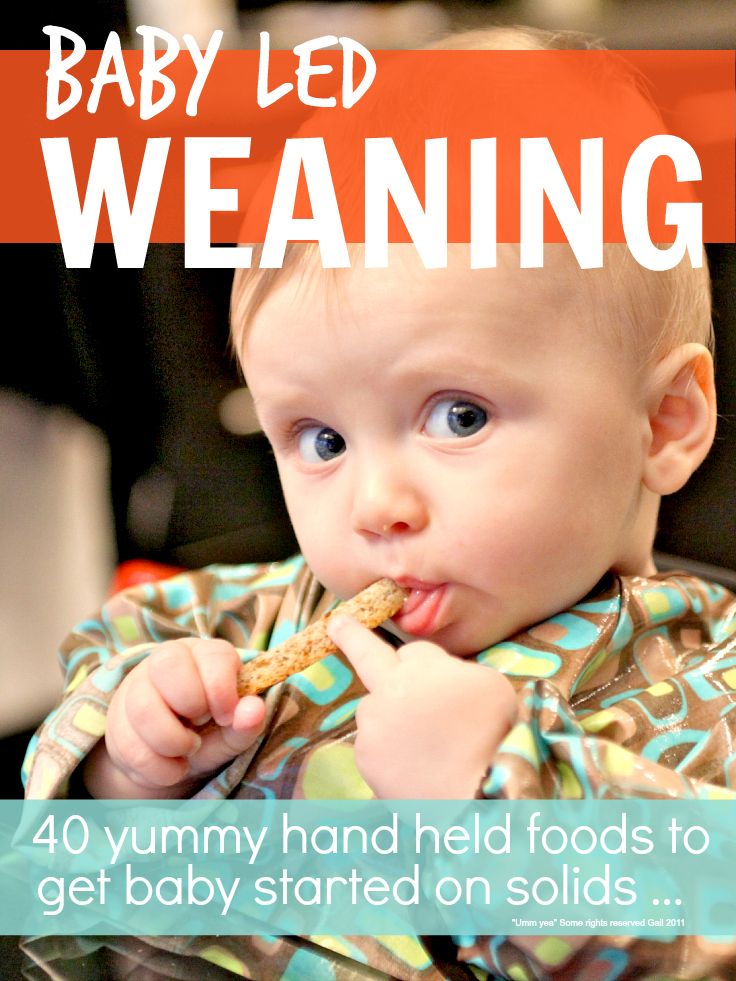 You are now preparing for another exciting milestone - introducing solid foods to your baby's diet. This is an exciting moment when your baby becomes more independent in eating. But, like all other stages of a child's development, this period requires a long adaptation. Like most parents, you probably want to know when to start introducing solid foods and how to introduce solid foods to your baby.
You are now preparing for another exciting milestone - introducing solid foods to your baby's diet. This is an exciting moment when your baby becomes more independent in eating. But, like all other stages of a child's development, this period requires a long adaptation. Like most parents, you probably want to know when to start introducing solid foods and how to introduce solid foods to your baby.
This article contains important information about introducing solid foods to your baby's diet (age-appropriate), tips for introducing complementary foods, and techniques to help you and your baby transition smoothly to the next level of nutrition.
At what age should complementary foods be introduced?
Be sure to check with your doctor when you think your child is ready to introduce new foods. There is no exact age at which complementary foods should be introduced. However, the introduction of complementary foods to children, both breastfed and bottle-fed, is recommended to start at the age of 4-6 months. At 6 months of age, a baby's energy and mineral needs increase. However, all babies are different and some may be ready for it as early as four months. Four months is the earliest age at which complementary foods can be introduced. Until then, the baby's gastrointestinal tract is not ready to absorb any other food besides breast milk or formula. Only a doctor will be able to assess the individual readiness of each child; no matter what his decision is, it is important to continue breastfeeding, gradually introducing solid foods along with it.
At 6 months of age, a baby's energy and mineral needs increase. However, all babies are different and some may be ready for it as early as four months. Four months is the earliest age at which complementary foods can be introduced. Until then, the baby's gastrointestinal tract is not ready to absorb any other food besides breast milk or formula. Only a doctor will be able to assess the individual readiness of each child; no matter what his decision is, it is important to continue breastfeeding, gradually introducing solid foods along with it.
The doctor will try to identify key signs that your baby is ready for solid foods: [1]
- The baby can sit up without assistance or can sit on mom's lap and hold her head.
- The “spoon push” reflex, a natural reaction of rejection of food, in which the child pushes the spoon out with the tongue (the child no longer sticks out the tongue when eating), has disappeared in the baby.
- The child has an active food interest (desire to try something from the table while adults are eating).
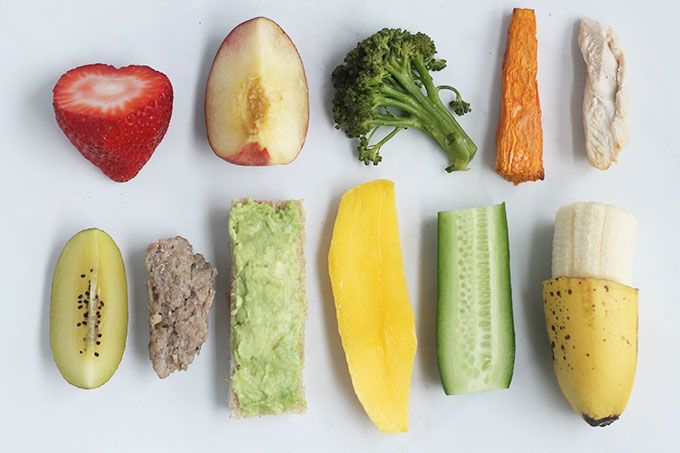
After your baby has mastered the skills necessary for independent feeding, including holding his head well, you can begin to introduce more solid foods into the diet.
Your baby's first foods
The moment you've been waiting for is finally here: your baby is ready to try solid food! Usually the products of the first complementary foods are vegetables and cereals.
If the baby is healthy, has no digestive problems and is gaining weight well, then, as a rule, weaning foods start with the introduction of vegetables.
Monocomponent vegetable purees are good for the first feeding. Vegetables are a source of organic acids, potassium, iron, fiber. It is recommended to start vegetable complementary foods with zucchini, broccoli and cauliflower. Initially, vegetable puree should consist of one type of vegetable. Then you can make a combination of various vegetables. Start with 1 spoon, then bring the volume to 180 grams.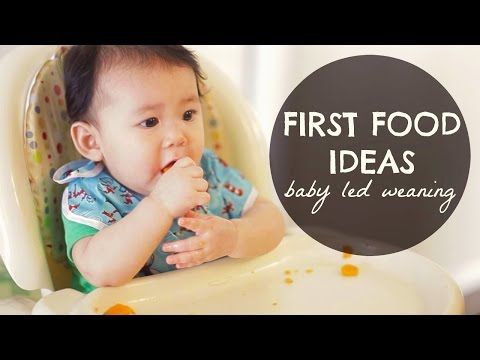 By the year, the amount of vegetable purees consumed per day is 200 grams.
By the year, the amount of vegetable purees consumed per day is 200 grams.
If the child is underweight or anemic, industrial cereals can be given as the first complementary food. As the first cereals, in order to avoid allergic reactions, it is recommended to introduce dairy-free gluten-free cereals. Mix one to two tablespoons of single-grain cereal with breast milk, or infant formula, or water. If the child is breastfed, give him complementary foods only after the main feeding, so that the child can first get enough breast milk; keep doing this until he is about
[2]
Once your child is used to their first meal, continue to introduce new foods such as fruit purees, cottage cheese, eggs, dairy products, and meat and fish purees. Before introducing each next product, you must wait three to five days to find out if the child is allergic to the previous one.
Steaming!
The inclusion of various foods in the diet is very important for the formation of taste habits in the baby. Steam a variety of healthy meals!
Steam a variety of healthy meals!
Steaming is one of the healthiest ways to cook baby food. Steamed products are very soft and juicy, unlike fried products, which, of course, is very popular with children. And most importantly, steamed foods preserve the most important vitamins and minerals.
Make healthy cooking easy and enjoyable with the Philips Avent 4 in 1 Steamer Blender. The 4 in 1 healthy baby food maker allows you to steam and grind food in one jug. In addition, with the Philips Avent Steamer Blender, parents can make solid foods for babies of all ages, from purees to chunks. Jug with a volume of 1l. designed to cook several servings at a time. So you can prepare several meals at once to feed your baby now, and also freeze the puree for next time in a special container that comes with the steamer. The defrost and keep warm functions will help you prepare lunch or dinner for your baby even faster.
The 4 in 1 Steamer Blender also comes with a recipe booklet developed with pediatric nutritionist Emma Williams.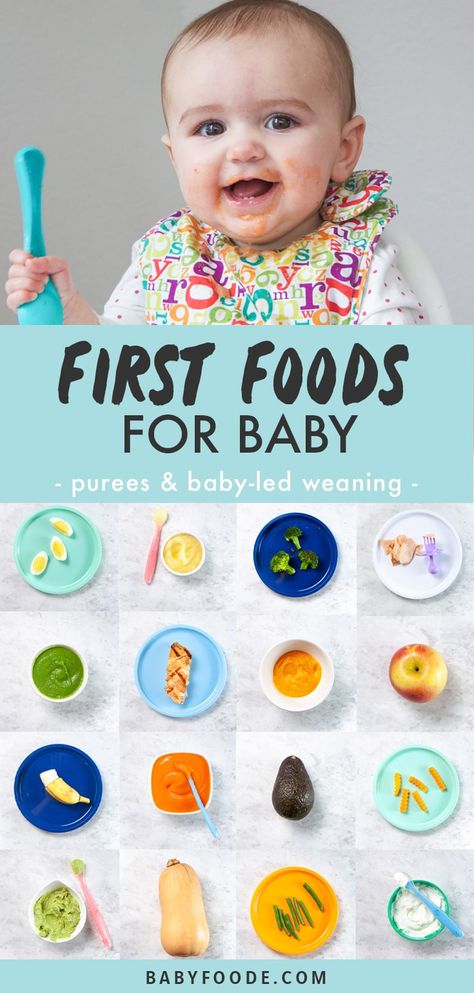 In the brochure you will find interesting recipes for preparing tasty and fresh children's meals, as well as useful tips on the introduction of complementary foods and interesting menu ideas. Instill healthy habits in your baby from an early age for healthy development.
In the brochure you will find interesting recipes for preparing tasty and fresh children's meals, as well as useful tips on the introduction of complementary foods and interesting menu ideas. Instill healthy habits in your baby from an early age for healthy development.
In addition to the joy your child will experience from a change in diet, it is important to be aware of the various food allergies that can occur during the introduction of complementary foods. Experts recommend starting to introduce commonly known food allergens when the baby is 4-6 months old. In addition, recent studies have shown that with a later introduction of complementary foods in children, the risk of developing food allergies increases, therefore, it is necessary to introduce such foods into the baby’s diet on time and not put them off for later. The most well-known G8 food allergens include: [2] [3]
- cow's milk;
- chicken eggs;
- fish;
- seafood;
- nuts;
- peanuts;
- wheat;
- soybeans.

If you or a family member has a food allergy, be sure to consult your pediatrician for the best solution for introducing the foods listed above to your child's diet.
In addition to introducing new foods into the child's diet, it is also necessary to teach him to drink water from the age of 6 months. During the first six months of a child's life, mother's milk provides him with the necessary amount of fluid, even in hot climates. But once your baby is 6 months old, you can start giving him little by little to drink from a non-spill cup.
Check out Avent's Soft Non-Spill Training Cup from the Natural series with comfortable handles to help your child learn to drink without help. It is easy to drink from it, because the liquid begins to flow out only when the child bites or sucks on the spout of the cup. The design of the cup makes it easy to hold with little hands.
From Puree to Finely Chopped Foods
Once your child has mastered the motor skills needed to eat more solid foods, you can move on to finely chopped foods.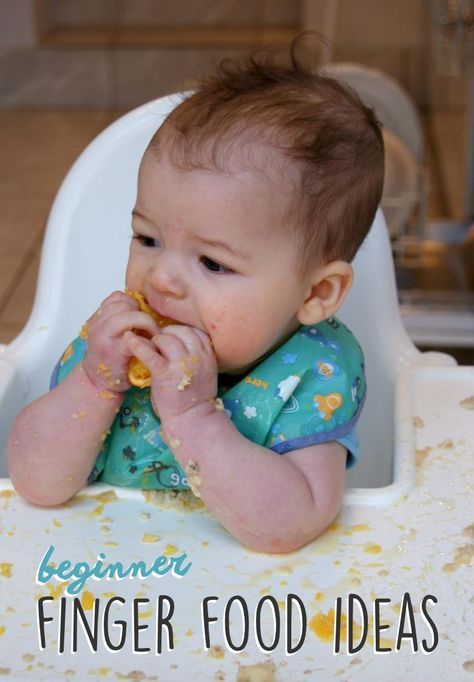 Each child is different, but usually chopped vegetables and meat can be introduced into the diet from nine months. [4]
Each child is different, but usually chopped vegetables and meat can be introduced into the diet from nine months. [4]
When you introduce crushed foods into your child's diet, try to get your child to take an active part in family meals. The baby can be offered boiled vegetables, pieces of soft fruit, well-boiled pasta, or small pieces of chicken.
Remember to check that the ground food is soft and well cooked so that the child can easily grind it into mush with his mouth. Meat, for example, has a tougher structure and fibers, and therefore requires more thorough grinding compared to fruits that are delicate in texture.
With the Philips Avent 4 in 1 Steamer Blender, you can customize your food consistency from puree to chunks. Also, the recipe book that comes with the double boiler will allow you to easily choose the right recipe for the age of the child.
Tips for getting started with solid foods
Here are some basic tips for introducing complementary foods to infants. As you introduce solid foods into your child's diet, we also recommend following other tips to help your child get used to the new food: [1]
As you introduce solid foods into your child's diet, we also recommend following other tips to help your child get used to the new food: [1]
- Offer food only when the child wants it. In a quiet environment or when other family members are having lunch, offer your baby a new product if he wants to try it.
- Introduce a new product in small portions in the morning. A new product should be administered in the morning to monitor possible reactions to the product. Remember that the introduction of new foods into the diet should not be considered a complete meal for the child. It is only about giving the child the opportunity to taste different foods, as well as to get a feel for their structure, gradually increasing their portions as the baby grows older.
- Offer your child a new product only when they are healthy. Do not introduce new foods when the child is sick or during the vaccination period.

- If the child does not like the product, postpone the tasting until a later date. This is a new experience for your baby, associated with new tastes and sensations. Therefore, do not be discouraged and do not worry if the child did not like the food the first time! Simply postpone taking this product until a later time.
- Never leave your child alone with food. Although the child is already taking the first steps in independent nutrition, this does not mean that he can be completely independent.
- Do not give your child foods that are too hard or slippery, rounded or choking on. These precautions will prevent the child from suffocation. Any rounded foods, such as grapes or carrots, should be cut into two or four pieces.
Goodbye liquid diet!
Proper weaning is an unforgettable experience for you and your baby. Complementary foods are very different from breastfeeding and bottle feeding, and you will certainly feel a sense of pride as your baby matures. Enjoy these precious moments. After all, before you know it, your child will grow out of his highchair and move on to a full three-course meal!
Enjoy these precious moments. After all, before you know it, your child will grow out of his highchair and move on to a full three-course meal!
Download the app and use trackers to track your child's development and growth, and keep those special moments forever.
Download app:
You are leaving the Philips Healthcare (“Philips”) official website. Any links to third party websites that may be included on this site are provided solely as a convenience to you. Philips makes no warranties regarding any third party websites or the information they contain.
I understand
You are about to visit a Philips global content page
You are about to visit the Philips USA website.
How to organize complementary foods for a baby under one year old / A detailed guide for young parents - an article from the "The Right Approach" section on Food.ru
When to start introducing complementary foods
Just yesterday, the whole world revolved around establishing breastfeeding or bottles, and today It is necessary to decide at what age to start feeding the child with other foods.
According to WHO recommendations, it is worth breastfeeding a baby at least up to 6 months, and preferably up to 2 years. And you should choose the time of the first complementary foods based on what kind of feeding the child is under one year old.
In the case when he is on natural (breast) feeding, experts recommend starting complementary foods no earlier than 6 months. If the child has been on artificial or mixed feeding since birth, then complementary foods should be introduced from 4 months.
The decision on when to introduce complementary foods is made only by the child's parents, and only after consultation with a specialist.
So, even those children who are on breastfeeding, but at the same time gaining weight poorly or they have problems with the absorption of milk, start feeding the same way at 4 months.
There are a number of factors, based on which parents understand that it is time to give the baby adult food:
-
the unconditioned reflex of pushing food out of the child has disappeared: he can take food from a spoon without pushing it out with his tongue;
-
the child sits confidently: we remember that it is impossible to sit girls down - this can negatively affect the formation of the pelvic organs;
-
the child shows food interest: looks into the plate to you or older brothers and sisters, tries to steal a piece or two).

Why is it important to decide when to start complementary foods? First of all, not only the health and active life of the baby depends on this, but also the formation of healthy eating habits in adulthood.
For example, if complementary foods are introduced too early, problems with the digestive tract can occur. In the first year of a child's life, the gastrointestinal tract is still being formed. And too early introduction of products other than breast milk or adapted formula can lead to indigestion. Plus, if the solid food swallowing reflex is not formed, then the child may simply choke.
It is not worth delaying the introduction of complementary foods. Too late is fraught with a number of problems:
-
iron deficiency anemia. By 6 months, the supply of iron that the baby received in the womb dries up. And there is very little iron in breast milk, it is not enough for a child;
-
lack of vitamins and microelements. Of course, breast milk contains all this in large quantities, but over time, the child needs more and more of them, and breast milk is not able to cover all the deficiencies;
-
fading food interest.
 It is difficult to feed a one-year-old child with something other than breast milk. And it is important not to miss the moment when the baby is really interested in trying new things;
It is difficult to feed a one-year-old child with something other than breast milk. And it is important not to miss the moment when the baby is really interested in trying new things; -
delayed physical and psychomotor development. Complementary foods are not only food, but also the formation of grasping skills, the development of large and small motor skills, all the sensory systems of the child's body.
Where to start introducing complementary foods
According to the same WHO recommendations, the first complementary foods for a baby are one-component vegetable purees or cereals. The choice of product depends on how much the child weighs, how he gains weight, whether he has a tendency to allergies, how his digestion works.
The pediatrician selects the scheme for the introduction of complementary foods by months, focusing on the child's history.
If vegetables are the first choice of complementary foods, then this is mashed marrow, cauliflower and broccoli. It is believed that white and green vegetables are hypoallergenic, and their fiber is tender, and the child's intestines can easily cope with it.
It is believed that white and green vegetables are hypoallergenic, and their fiber is tender, and the child's intestines can easily cope with it.
It is important to follow the rules and not make mistakes when introducing complementary foods.
-
Complementary foods first, then milk or formula. The point is that if you first feed the baby with his usual food, then after he is full and satisfied, he will simply refuse complementary foods;
-
Introduce foods gradually. Take your time - the child has a whole life ahead of him, he will have time to try everything and everyone. But now his body is not ready to adapt to new products every day. So the “one week per food” rule should apply throughout the feeding time;
-
Portions should be small. You can look at how a child eats vegetables, fruits, meat and cottage cheese with pleasure for an infinitely long time. And be touched. And after a long time to figure out why his stomach hurts, and run to the doctors.
 So we follow a simple rule: complementary foods are an inferior meal. This is 1-2 teaspoons per sample. Acquaintance with a new taste and tracking the body's reaction to the introduction of a particular group of products.
So we follow a simple rule: complementary foods are an inferior meal. This is 1-2 teaspoons per sample. Acquaintance with a new taste and tracking the body's reaction to the introduction of a particular group of products.
Common mistakes when organizing complementary foods for a child under one year of age:
-
introduction of complementary foods to a child during illness. All the forces of the body at this moment are thrown to defeat the disease. And feeding becomes a stressful situation. Be prepared for the fact that even after a successful start, in case of illness, the baby may again require only a breast or a bottle of formula. This is fine. This is a natural defense mechanism;
-
familiarization of the child with products not according to age. His gastrointestinal tract is still being formed. The norms for the introduction of complementary foods have been developed taking into account research on the readiness of the child's body to perceive and digest certain products up to a year;
-
start complementary foods with multicomponent foods.
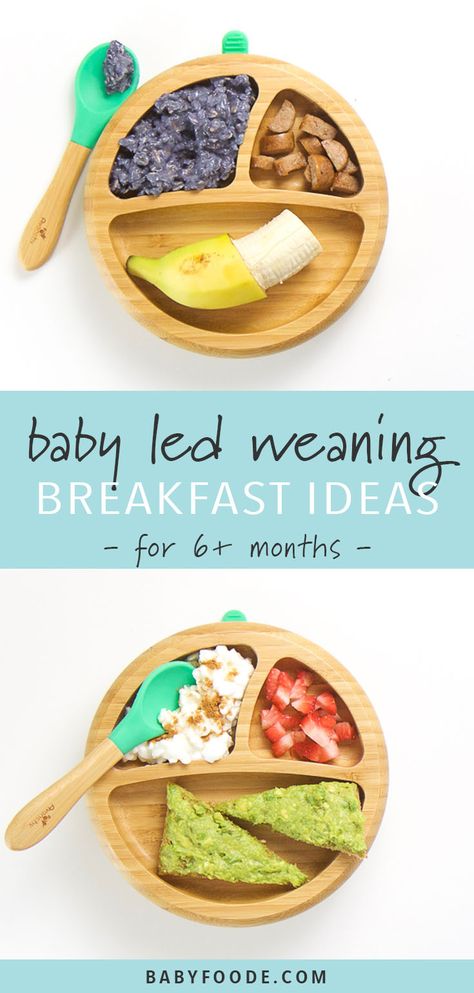 This is fraught with the fact that you will not be able to track which product the child has an allergy or food intolerance to.
This is fraught with the fact that you will not be able to track which product the child has an allergy or food intolerance to.
If the pediatrician recommends starting complementary foods with porridge, then the choice is made in favor of hypoallergenic, gluten-free cereals. Lure up to a year should start with buckwheat and rice. Later, wheat and oatmeal porridges are added to the complementary feeding scheme, and then multi-cereal, as well as cereals with the addition of pieces of fruits and vegetables.
Porridges are initially offered to the baby, cooked with water or breast milk. In the latter case, you need to be prepared for the fact that the porridge will be very liquid. Don't worry - it's normal. Breast milk enzymes eat up all the density.
Milk porridge - the second line of complementary foods. And they appear in the baby's diet much later, a month and a half after the introduction of cereals on the water.
It is worth remembering that porridge that you have already prepared should not be left until the next feeding, even in the refrigerator. There is a simple principle: cook and eat. This also applies to canned baby puree. An open jar can live in the refrigerator for no more than one day.
There is a simple principle: cook and eat. This also applies to canned baby puree. An open jar can live in the refrigerator for no more than one day.
And what's next
After vegetables and cereals have appeared in the baby's diet, you can gradually add fruit purees. They start with hypoallergenic ones from apples and pears, then from peaches and apricots, bananas. Exotic fruit purees (for this region) appear last.
Now more and more multi-component purees can be found on store shelves, where not only vegetables or fruits are based, but also their mixes. This is not a marketing ploy at all, but an attempt to teach children to eat vegetables.
That is why it is recommended to start complementary foods with vegetables rather than fruits. After sweet mango puree, the child will turn up his nose at the tasteless zucchini. But if on the contrary, then there is a chance that he will love cauliflower, broccoli, and even the Brussels cruciferous representative.
But what about meat
Meat in the baby's diet, according to the complementary foods tables, appears closer to 8 months for those who are breastfed, and after 6 months for those who started earlier, being on mixed or artificial.
Homogenized rabbit and turkey meat purees are the first to reach the child's table. It is dietary, rich in iron and vitamins. Then add chicken and veal puree. Pork is introduced last.
Things are more complicated with fish. It all depends on the allergic status of the child. If food allergies are not identified, then the first fish (cod) may appear in the diet as early as 10-11 months. If a child has a tendency to allergies or allergic reactions to other products are observed, then experts recommend waiting and starting to introduce fish after a year and a half.
It is almost impossible to avoid an allergic reaction or food intolerance if the child has a predisposition. It is more important to take everything under control. This is where a baby food diary can help.
This is where a baby food diary can help.
It should be started from the first feeding, carefully recording all the data: time, product, portion size and reaction of the baby. Such a diary also helps to identify the preferences of a child up to a year old, track all his reactions, and gradually form a menu for months.
No milk anywhere
The introduction of complementary foods does not mean that breastfeeding or formula feeding should be abandoned. Everything stays in place. The portions are just getting smaller. Breast milk helps the child's digestive tract digest new foods for him, and an adapted mixture is the basis of the diet after a year.
As for children's dairy products, cottage cheese, yogurt, kefir and biolact are introduced into the diet after 8-9 months.
Food without rules
Separately, it is worth mentioning the so-called pedagogical complementary foods. Usually it is practiced by mothers with children at breastfeeding, when the child is not the first. The meaning is simple: the child is allowed to take micro portions of food from an adult's plate, for example, one rice, a piece of apple, a small piece of boiled meat or fish.
The meaning is simple: the child is allowed to take micro portions of food from an adult's plate, for example, one rice, a piece of apple, a small piece of boiled meat or fish.
This is a story about nutritional interest, not pure complementary foods. And here it is very important to understand that pedagogical complementary foods are possible only if the whole family adheres to proper nutrition, vegetables and meat are on the table, steamed or by languishing and baking, because fried and smoked dishes are absolutely not suitable for a child under one year old.
Complementary foods are an exciting new journey that you and your baby will embark on when they are 4-6 months old. New tastes, different textures, spoon and fork adventures are waiting for you. And also porridge, smeared on the table, and pasta that fly around the kitchen. And all this in order to make the life of a little man filled with tastes. Agree, it's worth it.
What can be done?
Start keeping a food diary and record your child's favorite foods by month.



